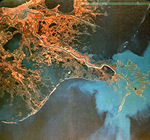Mississippi River
“In the space of one hundred and seventy-six years the Lower Mississippi has shortened itself two hundred and forty-two miles. That is an average of a trifle over one mile and a third per year. Therefore, any calm person can see that in the Old Oolitic Silurian Period, just a million years ago next November, the Lower Mississippi River was upwards of one million three hundred thousand miles long, and stuck out over the Gulf of Mexico like a fishing-rod. And by the same token any person can see that seven hundred and forty-two years from now the Lower Mississippi will be only a mile and three-quarters long...”
– Mark Twain on Mississippi River
“It is strange to see how humans value a stream of mud merely because it is big and boats float on it. I would not give two guineas for the Mississippi River, no, not unless it came with chips, ale, and a saucy maid.”
– Samuel Johnson on Mississippi River
The Mississippi River (a.k.a. Ol' Man River) is the largest river south of Yellowknife and north of Managua. It rises in a small spring in the basement of No. 33260 Hawthorn Boulevard, St. Cloud, Mninninnisota, and from there it takes the Holyhaven bus every morning as far as the Greenway Bridge where it begins its career as a river. Actually, it just keeps rolling along.
Geological History[edit | edit source]
The center of the North American continent is a basin enclosed on the east by the Appalachian ranges and on the west by the Rockies, and bounded to the north by the raised spine of the Canadian Border. For untold eons the Mississippi River has attempted to drain this immense swath of land. But to no avail: the whole thing is still a muddy, waterlogged mess every spring. It's a Sisyphean task the river has chosen, bitch.
In the last Ice Age the river froze, and many animals which would otherwise have perished strapped on their ice-skates and headed south. Behind them the great glaciers ground along like the Bulldozers of Doom. If not for the highway provided by the frozen Mississippi, the armadillo, the opossum, and the Cajun may have been ground to extinction under the glaciers.
The course of the Big Muddy changed yearly in the past, turning up in east Texas one year and the Florida panhandle the next. Indians had to put up with the river's migratory nature and called it "The River That Fucks With Landmarks" and "River-Over-There-Until-Yesterday." However the white man (not actually white and commonly called "Beigie") built cities along the river and he expected the river to stay put. And that brings us to...
Modern Man and the River[edit | edit source]

In a massive series of projects (cunningly called "The Volga River and Tributaries" project in order to throw off Japanese competitors) the US Army attacked the river along a broad front. As part of the War on Terra, engineers constructed thousands of miles of trenches, and when it was found that the trenches filled with water, they constructed earthen dikes instead. To cope with floodwaters a huge drain-plug was installed at the head of the Atchafalaya waterway. A winch 200 feet in diameter is used to pull the plug in time of flood. The Army keeps a flotilla of giant rubber ducks and a 500-foot plumber's helper nearby for emergencies.
However, the total sediment carried by the Big Muddy has decreased as man has built dam after dam on the upper river and on its tributaries. As a result the Mississippi Delta no longer gets a full load of vitamin-packed mud each spring. It's subsiding. An unexpected benefit of the proliferic dam building by the US Army Corpse of Engineers was the lack of drunken drowned Yankees floating downstream to further pollute the ecosystems in the “Yankee Free Zone” declared by all North, Central and South American citizens south of the Mason-Dixon Line following the War of Northern Aggression against the peace loving Southerners. Infiltration of the Snowbirds (a Yankee spy regiment) continues to this day.New Orleans sank below sea level and, after Hurricane Katrina struck, floated to Venezuela. Most delta blues singers are now singing two full steps below concert pitch. Alligators have to grow longer legs to reach down to the sinking ground or they are left thrashing in midair. Cypress groves are getting arthritis in their knees, and mangroves are dying out because they can no longer find woman-groves and mate.
But man's impact on the Mighty Missus-hip is not all negative. The fertility of the water grows almost daily with the application of vast quantities of manure and plain old shit pumped into the river by the Federal Shit Distribution Agency.
As Mark Twain wrote, "...there was nutritiousness in the mud, and a man that drunk Mississippi water could grow corn in his stomach if he wanted to."
Such words are doubly true today.
Myths of the river[edit | edit source]
Local employees of the nearby KFC factory have reported that multiple elephants have been spotted jumping in and out of the river, however other sources have provided the knowledge that the KFC employees were, in fact, high at this point in time. The elusive redneck is said to hunt for fish here.
Geography of the river[edit | edit source]
The southern part of the river goes through No Orleans, and was severly screwed over by Hurricane Isaac back in 2012, when it went the wrong fucking way and then the whole river exploded! But, then the water came back. For some reason Hurricane Katrina didn't manage. Then, it goes up, goes through Memphis(which is the largest city on the river), and then through poor nothingness. It then hits Cairo(no, not that one, THAT one!) The Middle Mississippi begins! This goes until Saint Louie, 190 miles later. The Upper Mississippi then goes. It's just....so long! Especially when it wanders in Minnesota for hundreds of miles.

